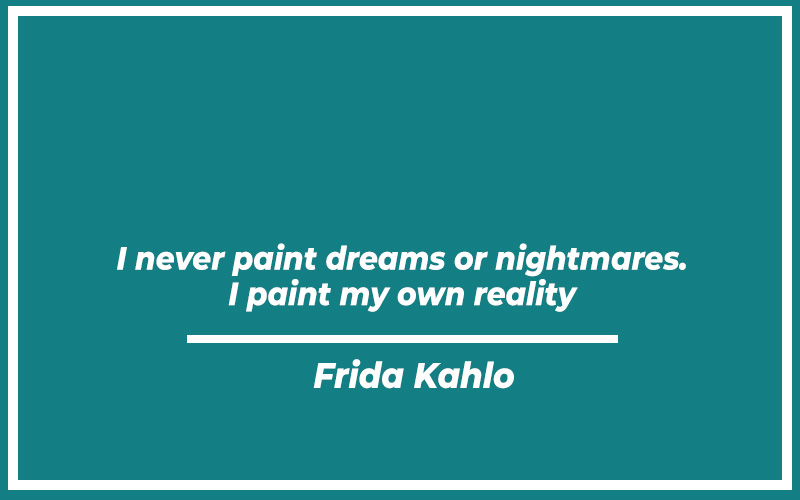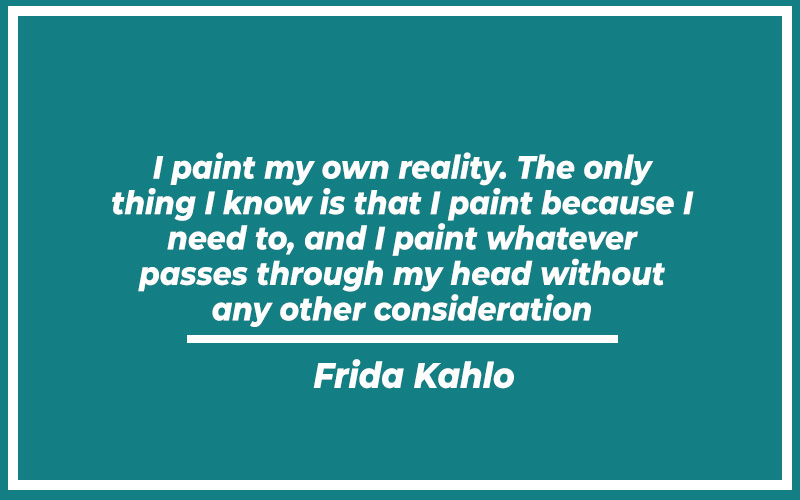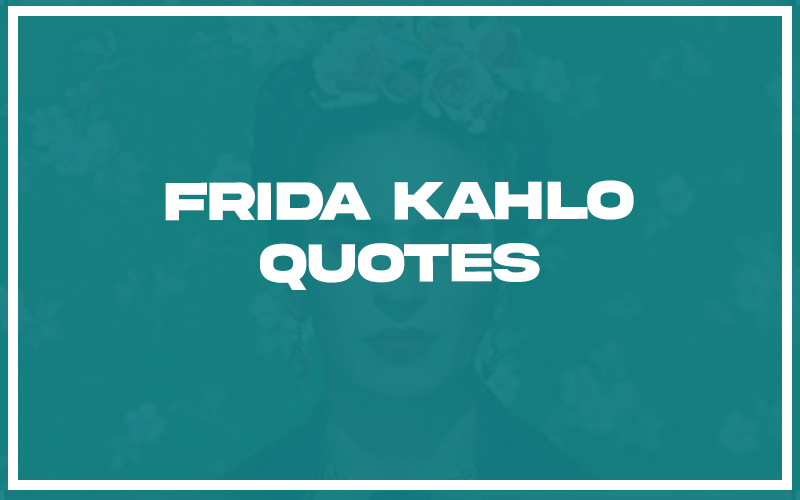Where are the artists in the house?! Painting allows us to capture the world around us, our emotions, and our stories in a single beautiful image. It’s such a powerful talent, the iconic Mexican artist, Frida Kahlo, was able to utilize this art beautifully.
Frida Kahlo’s life was full of passion, pain, and resilience. A survivor of a horrific accident, Kahlo turned to art as a way to express her experiences and inner world. Her self-portraits are some of the most recognizable in art history. they tell stories of her strength, and vulnerability.
Frida Kahlo Quotes

“Feet, what do I need them for when I have wings to fly.” — Frida Kahlo
This Frida Kahlo quote captures her spirit of transcendence and resilience. Despite being physically impaired by polio and a traumatic bus accident, she viewed her creativity and passion for art as her means of liberation.
This perspective allowed her to rise above her physical limitations and pain. Her “wings” symbolized her indomitable spirit and artistic expression, which provided her with a sense of freedom and empowerment. This quote reflects her ability to transform suffering into a source of strength and inspiration, showcasing her profound inner strength and unyielding determination.
Also Read: Calligraphy Quotes (with Explanation)
“I paint my own reality. The only thing I know is that I paint because I need to, and I paint whatever passes through my head without any other consideration.” — Frida Kahlo
Kahlo’s declaration of painting her reality underscores her commitment to authenticity and self-expression. She rejected external expectations and societal norms, choosing instead to portray her personal experiences, emotions, and pain. Her art was not about aesthetics or commercial success; it was a necessary outlet for her to process and communicate her inner world.
This approach resulted in deeply personal and evocative works that resonated with many. Kahlo’s focus on painting her truth without compromise highlights her revolutionary spirit and her dedication to honesty in her art.
“I paint flowers so they will not die.” — Frida Kahlo
This quote reveals Kahlo’s desire to capture and preserve beauty in her art. By painting flowers, she sought to immortalize their transient beauty, creating a permanent record of their existence. This act of preservation reflects her broader attempts to cope with the impermanence of life and her own mortality.
Through her art, Kahlo could defy the natural decay and fleeting nature of life, finding solace in the permanence of her creations. This sentiment also speaks to her appreciation for the small, delicate aspects of life and her ability to find profound meaning in them.
“At the end of the day, we can endure much more than we think we can.” — Frida Kahlo
Kahlo’s life was a testament to human endurance. She endured immense physical pain from her injuries and numerous surgeries, as well as emotional pain from her tumultuous relationship with Diego Rivera and her struggles with infertility. Yet, she continued to create and live passionately.
This quote is a powerful reminder of the strength that lies within all of us, often untapped until we are faced with adversity. Kahlo’s ability to endure and thrive despite her challenges serves as an inspiring example of resilience and the human spirit’s capacity to overcome hardship.
“I hope the exit is joyful and I hope never to return.” — Frida Kahlo
In this profound reflection on mortality, Kahlo expresses a longing for peace and a release from her suffering. Her hope for a joyful exit suggests a desire for a serene end to her pain and a final escape from the struggles she faced throughout her life.
This quote reveals her contemplation of death not with fear, but with a sense of anticipation for relief and tranquility. It encapsulates her complex relationship with life and death, highlighting her acceptance of mortality and her wish for a peaceful transition.
“I think that little by little I’ll be able to solve my problems and survive.” — Frida Kahlo
Kahlo’s optimism and determination are evident in this quote. Despite facing continuous health issues and emotional turmoil, she believed in her ability to gradually overcome her problems. This statement emphasizes the importance of perseverance and patience in the face of adversity.
Kahlo’s approach to life was one of resilience and hope, focusing on incremental progress rather than immediate solutions. Her belief in her capacity to survive and solve her problems, little by little, serves as an encouraging reminder of the power of persistence.
“Nothing is worth more than laughter. It is strength to laugh and to abandon oneself, to be light. Tragedy is the most ridiculous thing.” — Frida Kahlo
Laughter, for Kahlo, was a source of strength and a way to cope with the absurdity of tragedy. Despite her suffering, she recognized the healing power of laughter and its ability to lighten the burdens of life. This quote underscores her belief in the importance of joy and humor as tools for resilience.
By embracing laughter, Kahlo could momentarily escape her pain and find strength in moments of levity.
“I paint self-portraits because I am so often alone, because I am the person I know best.” — Frida Kahlo
Frida Kahlo’s self-portraits are a window into her soul. This quote highlights her introspective nature and the isolation she often felt. Through self-portraiture, Kahlo explored her identity, emotions, and experiences, making her art deeply personal and revealing.
She turned her solitude into a powerful tool for self-expression, using her own image as a canvas to communicate her inner world. This approach allowed her to confront her physical and emotional pain directly, transforming her art into a form of self-therapy and profound connection with viewers.
“I am not sick. I am broken. But I am happy as long as I can paint.” — Frida Kahlo
Kahlo’s distinction between being sick and broken reflects her understanding of her own fragility. Despite her physical and emotional suffering, painting provided her with a sense of purpose and fulfillment. This quote underscores the therapeutic role of art in her life, highlighting how creativity allowed her to navigate her pain and find moments of happiness.
By embracing her brokenness, Kahlo turned her vulnerabilities into strengths, using her art as a means to reclaim her identity and assert her resilience.
“There have been two great accidents in my life. One was the trolley, and the other was Diego. Diego was by far the worst.” — Frida Kahlo
This quote poignantly captures the tumultuous nature of Kahlo’s relationship with Diego Rivera. The trolley accident caused her immense physical suffering, but her emotional pain from her relationship with Rivera was even more profound. Despite their love and mutual artistic admiration, their relationship was fraught with infidelity and conflict.
Kahlo’s words reveal the deep emotional scars left by Rivera, portraying the complexity of love and the enduring impact of emotional pain. Her art often reflected this duality, blending themes of love and suffering.

“I never paint dreams or nightmares. I paint my own reality.” — Frida Kahlo
Kahlo’s rejection of surrealism in favor of realism emphasizes her commitment to authenticity. Her art was a direct reflection of her lived experiences, emotions, and perceptions. By painting her reality, she communicated her personal truth, rejecting the notion of art as mere fantasy.
This approach allowed her to address themes of pain, identity, and resilience with raw honesty. Kahlo’s dedication to depicting her reality made her work relatable and powerful, resonating with audiences on a deeply personal level and solidifying her legacy as a profoundly authentic artist.
“I drank because I wanted to drown my sorrows, but now the damned things have learned to swim.” — Frida Kahlo
This quote captures Kahlo’s struggle with alcohol as a means of coping with her pain. Despite her attempts to escape her sorrows, they persisted and even adapted. Her words reflect the futility of using substances to numb emotional pain and the resilience of her inner demons. This candid admission highlights the ongoing battle she faced with her mental and emotional health.
Kahlo’s honesty about her struggles adds depth to her legacy, showing her as a deeply human figure who confronted her pain with both vulnerability and strength.
“Take a lover who looks at you like maybe you are a bourbon biscuit.” — Frida Kahlo
Kahlo’s whimsical metaphor for love reveals her desire for a partner who sees her with a sense of delight and appreciation. This quote captures her yearning for genuine affection and admiration. By comparing herself to a bourbon biscuit, she conveys the importance of finding someone who values and cherishes her.
This lighthearted yet profound statement reflects Kahlo’s romanticism and her belief in the transformative power of love. Her relationships, though often tumultuous, were a central theme in her life and art, reflecting her deep capacity for love and passion.
“Nothing is worth more than laughter. It is strength to laugh and to abandon oneself, to be light. Tragedy is the most ridiculous thing.” — Frida Kahlo
Kahlo’s celebration of laughter as a source of strength highlights her ability to find joy amidst adversity. Despite facing immense suffering, she recognized the power of laughter to uplift and heal. This quote underscores her belief in the importance of maintaining a sense of lightness and humor, even in the face of tragedy.
By embracing laughter, Kahlo found a way to cope with her pain and maintain her resilience. Her perspective encourages others to find moments of joy and levity, even during the darkest times.
“They thought I was a Surrealist, but I wasn’t. I never painted dreams. I painted my own reality.” — Frida Kahlo
Frida Kahlo’s assertion that she painted her own reality rather than surrealist dreams underscores her commitment to authenticity. While many labeled her as a surrealist due to the fantastical elements in her work, Kahlo emphasized that her art was a direct expression of her lived experiences and emotions.
This distinction highlights her focus on personal truth and the raw depiction of her inner and outer worlds. By painting her reality, she offered an unfiltered view of her struggles, making her work profoundly relatable and impactful.
“I wish I could do whatever I liked behind the curtain of ‘madness’.” — Frida Kahlo
Kahlo’s longing to embrace her creativity without societal constraints reveals her desire for freedom and self-expression. The metaphor of the “curtain of madness” suggests a space where she could explore her passions and eccentricities without judgment.
This quote reflects her frustration with societal expectations and her yearning to live authentically. By wishing for this freedom, Kahlo highlights the often restrictive nature of societal norms and the liberating potential of embracing one’s true self, even if it means being labeled as “mad.”
“I hope the exit is joyful and I hope never to return.” — Frida Kahlo
In this poignant reflection on mortality, Kahlo expresses a desire for a peaceful end to her suffering. Her hope for a joyful exit suggests a longing for release from the physical and emotional pain that plagued her life. This quote reveals her acceptance of mortality and a wish for serenity in death.
It encapsulates her complex relationship with life and death, highlighting her desire for tranquility and an end to her enduring struggles. Kahlo’s contemplation of death is both solemn and hopeful, reflecting her deep introspection.
“I think that little by little I’ll be able to solve my problems and survive.” — Frida Kahlo
Kahlo’s optimism and determination are evident in this quote. Despite facing continuous health issues and emotional turmoil, she believed in her ability to gradually overcome her problems. This statement emphasizes the importance of perseverance and patience in the face of adversity.
Kahlo’s approach to life was one of resilience and hope, focusing on incremental progress rather than immediate solutions. Her belief in her capacity to survive and solve her problems, little by little, serves as an encouraging reminder of the power of persistence.
“I tried to drown my sorrows, but the bastards learned how to swim.” — Frida Kahlo
This quote captures Kahlo’s struggle with alcohol as a means of coping with her pain. Despite her attempts to escape her sorrows, they persisted and even adapted. Her words reflect the futility of using substances to numb emotional pain and the resilience of her inner demons. This candid admission highlights the ongoing battle she faced with her mental and emotional health.
Kahlo’s honesty about her struggles adds depth to her legacy, showing her as a deeply human figure who confronted her pain with both vulnerability and strength.
“You deserve the best, the very best, because you are one of the few people in this lousy world who are honest to themselves, and that is the only thing that really counts.” — Frida Kahlo
Kahlo’s recognition of the rarity and value of self-honesty underscores her belief in the importance of authenticity. This quote is a powerful affirmation of self-worth, encouraging individuals to embrace their true selves and recognize their inherent value. Kahlo’s appreciation for honesty reflects her own commitment to living authentically and her disdain for pretense.
By highlighting the significance of being honest to oneself, she encourages others to reject societal expectations and embrace their unique identities.
“My painting carries with it the message of pain.” — Frida Kahlo
Kahlo’s acknowledgment of the pain embedded in her art reflects her use of painting as a means to process and communicate her suffering. Her works often depicted her physical and emotional struggles, making them deeply personal and evocative. This quote highlights the therapeutic nature of her art and its role in expressing her lived experiences.
By channeling her pain into her paintings, Kahlo created a powerful and relatable body of work that resonates with viewers on an emotional level, showcasing the cathartic power of art.
“Nothing is absolute. Everything changes, everything moves, everything revolves, everything flies and goes away.” — Frida Kahlo
This quote reflects Kahlo’s understanding of the impermanence of life. It speaks to the constant flux and transformation inherent in existence. By acknowledging that everything is transient, she captures the essence of life’s unpredictability and the inevitability of change.
Kahlo’s acceptance of change and her ability to adapt to life’s uncertainties reveal her resilience and philosophical outlook, encouraging others to embrace the ebb and flow of life.
“I want to be inside your darkest everything.” — Frida Kahlo
Kahlo’s desire to be intimately connected with the depths of another person reveals her intense passion and empathy. This quote highlights her willingness to engage with and understand the most hidden and vulnerable aspects of a loved one. Her art often explored themes of intimacy and emotional depth, reflecting her profound connections with others.
By expressing a desire to be part of someone’s darkest experiences, Kahlo shows her commitment to unconditional love and support, emphasizing the importance of deep, meaningful relationships.
“Pain, pleasure, and death are no more than a process for existence. The revolutionary struggle in this process is a doorway open to intelligence.” — Frida Kahlo
Kahlo’s view of life as a series of interconnected experiences of pain, pleasure, and death reveals her holistic understanding of existence. She saw these experiences as integral to the human condition and as opportunities for growth and enlightenment.
By framing these experiences as part of a revolutionary struggle, Kahlo highlights the transformative potential of adversity and the importance of intellectual and emotional resilience.
“I never knew I was a Surrealist till André Breton came to Mexico and told me I was.” — Frida Kahlo
Kahlo’s remark about her identification with Surrealism highlights the external perceptions of her work versus her own understanding. While André Breton, a key figure in the Surrealist movement, recognized surreal elements in her art, Kahlo maintained that she painted her reality.
This quote underscores the fluidity of artistic labels and the sometimes arbitrary nature of genre classifications. It also emphasizes Kahlo’s commitment to portraying her truth, regardless of external interpretations, showcasing her authenticity and dedication to personal expression.
“I am that clumsy human, always loving, loving, loving. And loving. And never leaving.” — Frida Kahlo
This quote encapsulates Kahlo’s boundless capacity for love and her unwavering loyalty. Despite the challenges and heartbreaks she faced, her commitment to love remained steadfast. Her intense emotions and deep connections with others are evident in her relationships and her art.
By describing herself as “clumsy” yet persistent in love, Kahlo acknowledges her imperfections while celebrating her dedication to those she cared about. This sentiment highlights the importance of unconditional love and the enduring nature of true affection.

“I paint my own reality. The only thing I know is that I paint because I need to, and I paint whatever passes through my head without any other consideration.” — Frida Kahlo
Kahlo’s commitment to painting her own reality underscores her dedication to self-expression and authenticity. She rejected external expectations and societal norms, choosing instead to portray her personal experiences, emotions, and pain. Her art was not about aesthetics or commercial success; it was a necessary outlet for her to process and communicate her inner world. This approach resulted in deeply personal and evocative works that resonated with many.
Kahlo’s focus on painting her truth without compromise highlights her revolutionary spirit and her dedication to honesty in her art.
Also Read: Buford T. Justice Quotes (with Explanation)
Final Thoughts
The beauty of Kahlo’s art lies in its ambiguity, its ability to hold multiple meanings and resonate with viewers on a personal level. Her quotes share that same quality, inviting us to ponder and find our own meaning within her words.
Exploring Frida Kahlo’s quotes is more than just understanding the artist; it’s a way of honoring her legacy. It’s a chance to connect with the woman who poured her heart and soul onto the canvas, transforming her experiences into art that continues to move and inspire us today.

